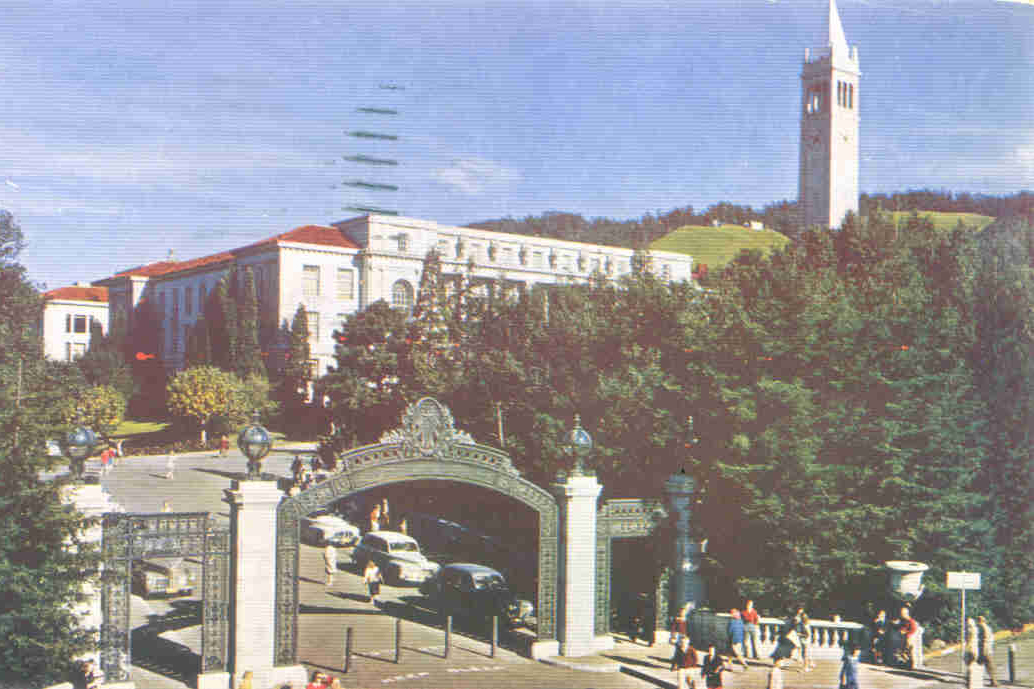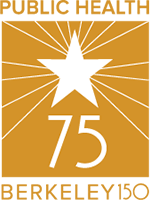 1940s postcard of Sather Gate (mailed in 1951).
1940s postcard of Sather Gate (mailed in 1951).
In 1942, the Committee on School of Public Health made the case for establishing a public health school in California, concluding:
“California has long been a leader of public health progress among the Western States. It supports one of the greatest state universities in the nation. This State and this University are the logical place for a public health school which will become the alma mater for future Western health leaders. The State owes it to its own citizens to provide them with the best trained public health officials in the world. It is a necessary public service not only to California but to the entire West.”

The analysis, which was reviewed and approved by the Northern California Public Health Association, was attached to Assembly Bill 515, introduced to the California Assembly by Assemblymen Carlson and Carey in January of 1943. The bill passed to the California Senate on April 12 and the Senate passed it and sent it to then Governor Earl Warren at 2 p.m. on May 5. On May 13, then UC President Gordon Sproul sent the governor a letter urging his signature on the bill. On June 8, 1943, Governor Warren approved the bill providing for the establishment of a school of public health in the University of California and making an appropriation of $87,000 to the UC Regents. (This would be about $1.2 million in today’s dollars.)
Looking at the establishment of the UC Berkeley School of Public Health within 1943, nothing could seem more straightforward. California government, health experts, and academia agreed upon a need and came together in order to serve the greater good and train future health leaders to the benefit of the California, the West, and—eventually—the world. And indeed that did happen. But it’s not the full story. Like so many successes, this one was delivered by the inability of a few visionaries to accept failure. One of these visionaries: Dr. K.F. Meyer.
From Basel to Berkeley
Karl Meyer was born in Basel, Switzerland, in 1884 and grew up in a three-story stone house near the Rhine where he mastered many of the “gentlemanly” arts—fencing, horseback riding, mountaineering. He first attended the University of Basel in 1902, but transferred to the University of Zurich in order to better apply himself to his studies. He received the equivalent of a BA from there in under 3 years, and earned a doctorate in veterinary medicine—then a field concerning the etiology of animal diseases like rabies, bovine tuberculosis, and foot-and-mouth disease.
Meyers then took a three-year contract in South Africa as a pathologist at the Veterinary Bacteriological Institute, particularly to develop rabies vaccine in case of outbreaks but he also did autopsies on all the lab animals. When he returned to Switzerland in 1910, he found he no longer fit in there, in part because he dressed like a colonial and “walked around in tropical clothes with a big double-rim sombrero hat.”
“The relationship with the students was perfectly marvelous, the echo from them was unbelievable; it was perfect.”
The British ambassador to the United States, whom he had befriended in South Africa, suggested Meyer should see the United States and connected him with a teaching position in pathology and bacteriology in the School of Veterinary Medicine at the University of Pennsylvania. After a year, he was promoted to full professor and was in charge of a lab. However, Meyer felt like an outsider in Pennsylvania as well, and he also clashed with the faculty on the preparedness of the students.
“When it came to clinical laboratory demonstration I had the keenest disappointment,” he recalled. “The students didn’t know any histology; they couldn’t recognize a kidney from a spleen.” So when a close colleague suggested a move to California, Meyer was open to the idea, despite being skeptical that they wanted to “park K.F. out on the Pacific.”
Meyer took a professorship of bacteriology and protozoology at UC Berkeley in 1913, with the understanding that he would only teach one semester and the other would be devoted to research. When he got there, he found out that a recent rule passed by the Academic Senate meant he would have to teach two semesters. He recalled, “I slapped my fist on the desk and I said, ‘If I stay here more than a year, my name is John.’”

He ended up staying at UC Berkeley and UCSF for more than 40 years, where he became one of the world’s most prodigious investigators in animal diseases and public health. Although initially angry with the course load, he found the “relationship with the students was perfectly marvelous, the echo from them was unbelievable; it was perfect.”
He “slid into” the field of epidemiology when he joined the faculty at the Hooper Foundation for Medical Research at Parnassus, UCSF, in 1915. There was a famous outbreak of typhoid epidemic, where over 120 cases of typhoid developed from from a spaghetti pie served at a single church dinner. As one of his first assignments, Meyer was called to work on the problem. He found that the woman who cooked the pie was a carrier of typhoid and had given many people the disease in the preceding six years. The experience convinced him of the importance of epidemiology in public health.
“I was public health conscious from the beginning, due to the fact that whenever I was following up an infection I could very clearly see that from a preventive point of view nothing had been done or no effort was being made,” he said.
The public health pass around
In 1919, UC Berkeley established a Department of Hygiene, where students were trained to become state-licensed sanitarians and laboratory technicians. The department cooperated closely with the State Health Department—state researchers and department faculty shared laboratory facilities in the Life Sciences Building on campus and often conducted joint research. State health officers could often be found taking classes at the Department of Hygiene. And Meyer became a consultant to the State Health Department in 1919, a relationship which continued for decades.

“Whenever they wanted some technical advice they came upstairs or they asked me to come downstairs and I usually stopped by and saw what they were doing,” he recalled. “If I was interested, well, I stuck my hands in it and took the problem and walked off with it.”
This close relationship raised awareness of the need for formal public health training on the west coast. But it wasn’t until 1935 that a real opportunity for funding arose when the Social Security Act was passed by the United States legislature. Beyond establishing social security, the Act included several additional provisions. One was Title VI, which appropriated about $10 million in funds for public health services and training to the states. The federal government wanted some of that money to go toward establishing a school of public health in the western states. This request was made of the State Board of Public Health, which then directed it to the University of California. Dr. Wilton Halverson, then director of the California Department of Public Health wrote:
“The need is particularly acute…It is also our conviction that, providing standards of training were equal, personnel trained in California would be better qualified to do effective work in this state than if they were trained in the East.”
Or as Meyer put it: “This was proposed to the State Board of Health, who promptly hollered ‘No, can’t the University do this?’”
Meyer took the idea to then UC President Robert Gordon Sproul, who took it to the Regents. But the Regents were concerned about the funding it would take and ended up suggesting to Meyer that he set up a curriculum of public health within the Department of Hygiene, using, essentially, a budget of zero from the University itself. And Meyer set out to do it.
A unique sort of program
First, Meyer made a deal with then Surgeon General Hugh S. Cummings to be able to charge $250 per student for the curriculum, which would result in a Certificate in Public Health. He also convinced the U.S. Public Health Service to ask the 15 western states to contribute to the funding of the program, which many of them did. He ended up raising about $40k to run the program (which would be about $700k today), and developed and launched the curriculum without having yet collected any of the money.
“I paid only $5 per lecture to which everybody objected and raised Holy Cain. Justly so, but I didn’t have any more.”
Professors and lecturers taught the coursework to the first 17 students with only promises of later payment from Meyer: “I paid only $5 per lecture to which everybody objected and raised Holy Cain. Justly so, but I didn’t have any more.”
Dr. Sanford S. Elberg, who later went on to become the dean of the Graduate Division at UC Berkeley, was a freshly minted graduate with a Bacteriology degree from UC Berkeley when Meyer asked him to assist in the lecture work for the public health curriculum. Meyer offered to get Elberg a stipend from the National Youth Agency, which was an organization headed by Eleanor Roosevelt that gave money to students for employment in colleges.
“The Curriculum in Public Health was enormous, in the sense that he used faculty from all the adjacent institutions of the Bay Area—Stanford, UC Med, Berkeley, Davis, the State Department of Health, and so on, from all his professional contacts,” recalled Elberg.
Dr. E.S. Rogers, who would become the School’s second dean, described the curriculum as “a very unique sort of program, intensive and highly personalized. [Meyer] is a dynamic personality; class would start at one o’clock and end at eleven p.m.”
At the same time the Department of Hygiene began offering short courses for sanitarians and sanitary inspectors as well as a course for health officers who weren’t qualified for the four-year program. The department trained more students than ever before and, in May 1937, graduated 17 students with a Certificate in Public Health: 14 health officers, one public health engineer, one public health laboratory technician, and one statistical technician. The program was a success and Dr. Meyer and fellow bacteriologist Charles Lipman submitted a report to UC President Sproul, once more expressing the need for a school of public health in California.
“It is our firm conviction that, whether or not financial assistance is rendered, the University of California through such grants as we are now obtaining form the United States Public Health Service or from foundations or other sources, it is our duty as a state university to offer adequate training for those persons who are preparing to assist in the far-flung public health program of the country which is now shaping itself. This is our conviction because we believe that the people of any state look to the state university to take the initiative in matter which are so vital to the public weal as the conservation of the health of the community.”
However, this report was also rejected by the Regents. So no school was established and then money ran out for the fledgling public health curriculum. In desperation, Meyer asked President Sproul for just $5,000 a year to run the program, but was rebuffed again and shut it all down in 1939.
California comes together
But pressure was building to upgrade public health services in California through a school of public health housed in the University of California. The Department of Hygiene faculty were for it, members of the State Department of Public Health were for it, Meyer was obviously for it.
It was at this time that Meyer assembled a team to help, including representatives from the American Social Hygiene Association, the California Tuberculosis Association, the San Francisco Board of Health, the American Red Cross, the U.S. Public Health Service, and Stanford’s Medical School. Bill Shepard, VP at the Metropolitan Life Insurance Company served as the head lobbyist to Sacramento.
“[Meyer] was such a clever politician that he knew he shouldn’t be the principal spokesman in Sacramento,” said Bill Reeves, fourth dean of the School of Public Health, in an oral history.
In 1942, the Northern California Public Health Association together with the California Medical Association formed a committee to present the need for a California school of public health to the state legislature. Their review emphasized the differences in the health problems faced by the East and the West:
“Western health problems are different from those in other parts of the country. In California we deal with the diseases particular to the alkali desert and the dangers presented by ports open to the Orient. There is a difference in Western culture which public health officers and their assistants must recognize…. It is even said that Western politics are different and, if so, the Western health officer should know it.”
The lobbying group was very successful in presenting their case, in part because Governor Earl Warren had just been elected and he held public health research to be of great importance—one of his campaign promises was to reorganize the Department of Public Health. Assembly Bill 515, which was, as quoted, “an act to provide for the establishment and maintenance of a School of Public Health in the University of California and making an appropriation therefore,” was passed in Governor Warren’s first legislative session.

Dr. E.S. Rogers would later reflect on the process, “This was a most unusual way to have a department of the University come into being. Normally the state legislature doesn’t set up an academic program. … The Warren administration of course was exemplified by a very close supportive relationship between the university and state government.”
On March 23, 1944, The Daily Californian ran an article titled “First Western Public Health School Begun,” signifying a turning point for public health as a consolidated discipline in the Western States. And the rest, as they say, is history.














